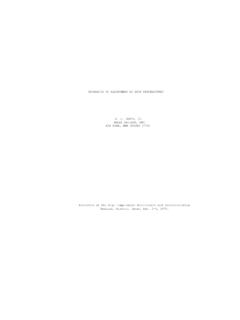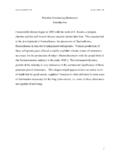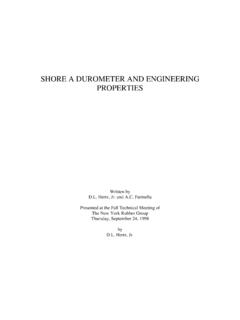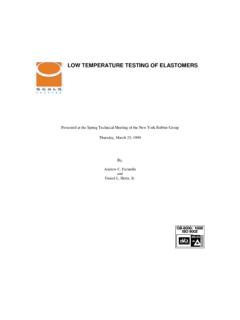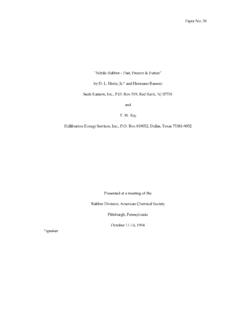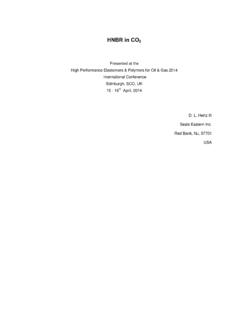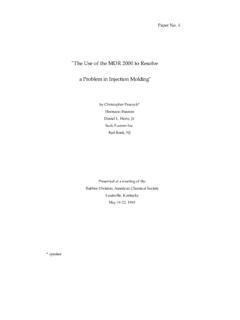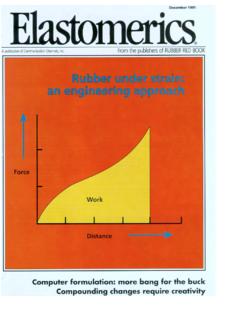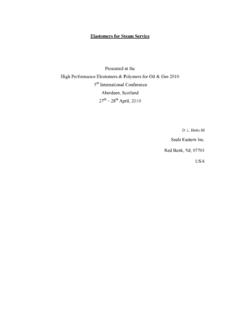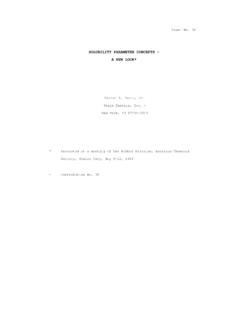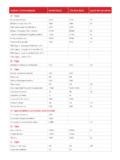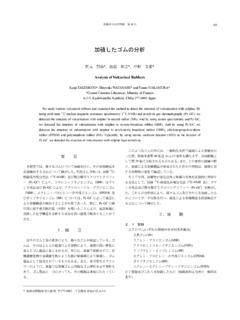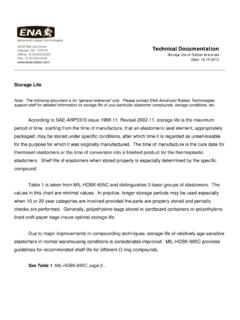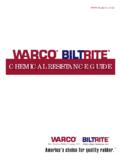Transcription of Theory & Practice Of Vulcanization - Seals Eastern
1 Theory & Practice Of Vulcanization DANIEL L. HERTZ, JR. Seals Eastern INC. RED BANK, NJ 07701 This paper concerns the Theory and Practice of Vulcanization - the process of adding crosslinks to long-chain molecules. It consists of three parts: Theory of Vulcanization Vulcanization of specific elastomers Influence of crosslink type and density on mechanical properties Theory A practical rubber product is developed by incorporating crosslinks which chemically tie together the independent elastomer chains. This process is generally referred to as Vulcanization , and a better understanding can be developed by considering the following statements: 1. "Much of our understanding of polymer chemistry is based upon the very basic assumption that the reactivity of a given group is unaffected by the size of the molecule of which it forms a part.
2 "(1) 2. "The essential requirement for a substance to be rubbery is that it consist of long, flexible chain-like molecules. The molecules themselves must therefore have a backbone of many noncollinear single valence bonds, about which rapid rotation is possible as a result of thermal agitation."(2) Fig. 1 illustrates the various degrees of mechanical freedom of an individual natural rubber molecule, represented by major torsional rotation and minor degrees of stretching and bending. Comparison with Fig. 2 makes it quite apparent that polymers having ring structures in their backbone cannot be rubbery. 3. "It is now well established that the stress in a deformed (elastomeric) network originates within the chains of the network.
3 "(3) 4. "According to the Theory of rubber elasticity (Flory), the retractive force resisting Vulcanization , the process of crosslinking elastomers, occurs by a chemical process initiated through some form of energy input. It occurs between two statistically favorable reactive sites. Such sites are available through one or more of the following conditions: Inherent. Double bonds in diene-containing elastomers. Specific. Double bonds pendant to the polymer backbone from cure-site monomers (EPDM, etc.). Chemically induced. Reactive sites left by the abstraction of backbone hydrogen or halogen atoms. The sites are coupled to each other by covalent bonding via one or more of the following mechanisms: a deformation is proportional to the number of network - supporting chains per unit volume of elastomer.
4 A supporting chain is a segment of polymer backbone between network junctures (crosslinks). An increase in the number of junctures gives us an increase in the number of supporting chains."(4) In summary, the rubbery aspect of an elastomer is imparted by the individual long-chain molecules. The load-supporting capabilities of the rubbery network result from tying together these individual chains through chemical crosslinks. Vulcanization of Specific Elastomers Carbon-carbon bonds through the backbone. Insertion of difunctional curatives such as sulfur between reactive sites. Insertion of di- and multifunctional monomers such as acrylates, phenolics, or triazines between reactive sites. In practical Vulcanization , the most widely used group of elastomers consists of those containing a diene site for crosslinking, ; Natural rubber (NR) and Polyisoprene (IR), Butadiene rubber (BR), Styrene-butadiene rubber (SBR), Isobutene-isoprene rubber (Butyl, IIR), and Nitrile-butadiene rubber (NBR), which are crosslinked by using sulfur as a vulcanizing agent.
5 The basic ingredients for a sulfur cure are: Sulfur or sulfur donor (crosslinker), Zinc oxide and fatty acid (activator), Organic accelerator(s). Sulfur. The original and still the most widely used curative, because of its versatility and cost, sulfur exists in the elemental state as an eight-membered ring (S8). The sulfur ring opening mechanism, as discussed by Coran (5), involves either a free radical or an ionic mechanism. The ionic mechanism is probably more logical, and can be rationalized in terms of the generalized Lewis acid-base interactions discussed by Jensen (6). Zinc Oxide. This has been an important ingredient since the early days of rubber compounding. Originally used as an extender to reduce cost, it was subsequently found to have a reinforcing effect, and was later found to reduce Vulcanization time.
6 Organic accelerators, which further reduce cure times, depend on zinc oxide to activate them. Zinc, as a metal, is classified as a d-transition element. As such, it is capable of developing relatively rare 5-coordinate complexes with fatty acid and organic accelerators. In the crosslinking of chlorine-containing compounds, it readily abstracts chlorine. The zinc oxide becomes zinc chloride, a very strong Lewis acid, and the reaction proceeds at an auto catalytic rate. Zinc oxide also is a very effective heat stabilizer in peroxide-cured elastomers. It serves no function in this crosslinking mechanism, however. The only adverse reaction of zinc oxide is in epichlorohydrin elastomers ( , Herclor, Hydrin).
7 The formation of zinc chloride (strong Lewis acid) causes an acid-catalyzed backbone cleavage. The subsequent effect is a polymer rearrangement that occurs by a keto-enol tautomerization mechanism. Fatty acids. Chemically, these are aliphatic carboxylic acids. The highly polar carboxyl group is very reactive through its ability to develop covalent and coordinate bonds and its H-bonding activity. The aliphatic hydrocarbon chain component is equally nonpolar and as such is highly soluble in nonpolar components. Zinc oxide and fatty acid constitute the activator system, in which the zinc ion is made soluble by salt formation between the acid and oxide (7). Fatty acids have long hydrocarbon chains with carbonyl oxygen that probably coordinates with the zinc through ligand formation.
8 The zinc complex thus formed is hydrophilic in the metal center and hydrophobic on the outside, the hydrophobic component being very soluble in the hydrocarbon (diene) component of the elastomer. Organic Accelerator(s). These all contain nitrogen and can perform as electron donors or acceptors as noted by Jensen (6). The mechanisms are discussed in detail by Coran (8) and appear to proceed in the following steps: (a) "The accelerator (Ac) reacts with sulfur (Sx) to give monomeric polysulfides of the type Ac-Sx-Ac, where Ac, is the organic radical derived from the accelerator." (b) "The polysulfides can interact with the rubber to give polymeric polysulfides of the type rubber-Sx-Ac. (c) "The rubber polysulfides then react, either directly or thru a reactive intermediate, to give crosslinks or rubber polysulfides of the type rubber-Sx-rubber.
9 " Influence of Crosslink Type and Density The five statements quoted above in the Theory section make it apparent that crosslinks create a profound effect on the mechanical properties of a vulcanized elastomer. The effect can be summarized by considering first the crosslink density, and then the individual crosslink type. Crosslink density or crosslink concentration of a network is described by Funke (9) in terms of: Mean molecular weight (Mc): Average mass of a polymer chain which connects two adjacent crosslinks. Crosslink density: Moles of crosslinked basic units per weight unit of the crosslinked polymer. Degree of crosslinking: Moles of crosslinked basic units per total moles of basic units. Crosslinking index: Crosslinked basic units per primary (linear) macromolecules.
10 Mean Molecular Weight (Mc) Considering the average molecular weight of the individual monomeric units (constitutional repeating unit or CRU) to be 70, different investigators have come up with varying values for an adequately crosslinked elastomer. Nielsen, by plotting shear modulus versus temperature in Fig. 3, confirms Southern who relates tensile strength to Mc. The practical Mc value is typically between 8,000 to 10,000 (114-142 CRU's). Crosslink Density Effects Coran (14) illustrates the major effects of Vulcanization by the idealization of Fig. 4. He notes that "the static modulus increases with Vulcanization to a greater extent than the dynamic modulus. The dynamic modulus is a composite of viscous and elastic responses, whereas the static modulus is a measure of the elastic component alone.
